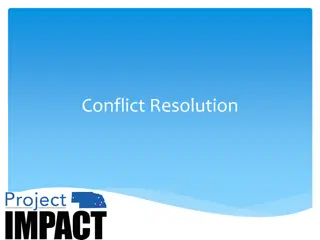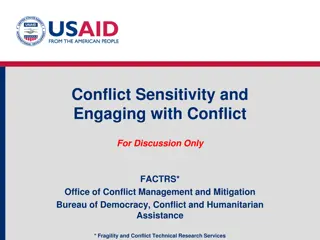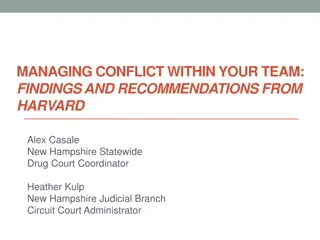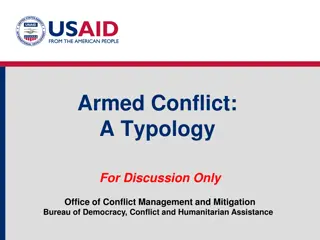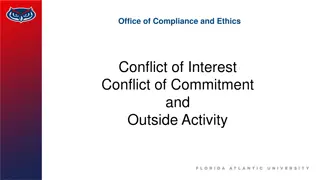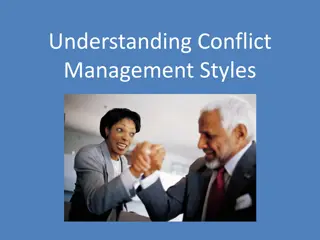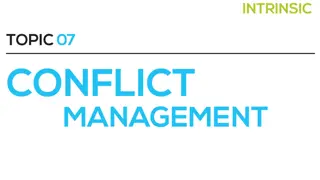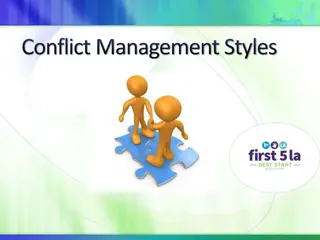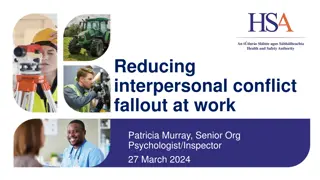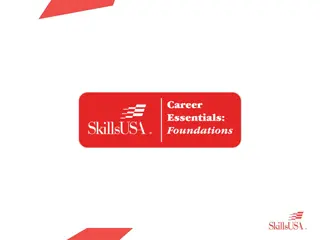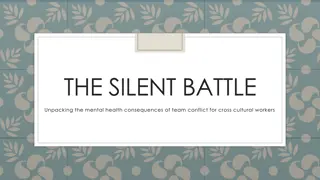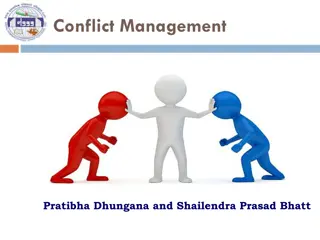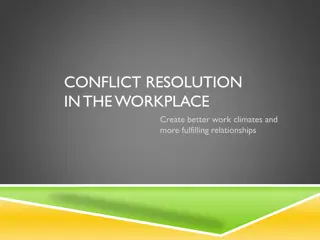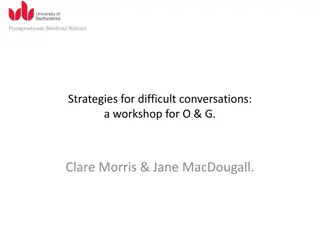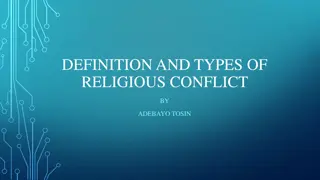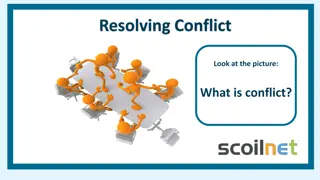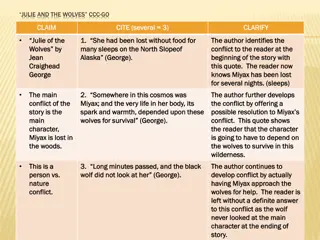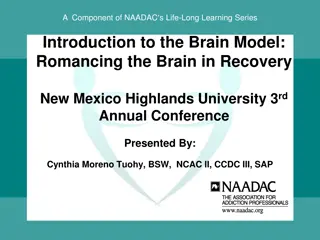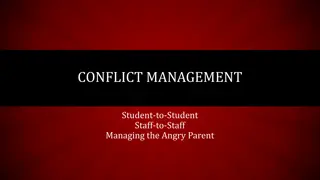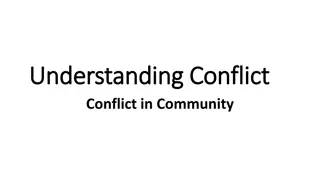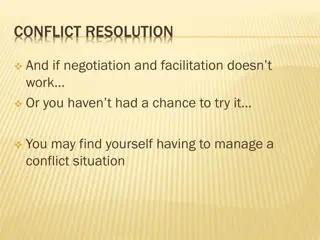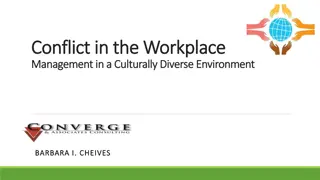Understanding Conflict: Key Concepts and Definitions
Explore the key concepts and definitions of conflict as discussed by Dr. Jared O. Bell, a visiting scholar at the University of the Gambia. Delve into the various levels, aspects, types, and styles of conflict, along with its sources and tractability. Gain insight into both the negative and positive impacts of conflict in different contexts.
Download Presentation

Please find below an Image/Link to download the presentation.
The content on the website is provided AS IS for your information and personal use only. It may not be sold, licensed, or shared on other websites without obtaining consent from the author. Download presentation by click this link. If you encounter any issues during the download, it is possible that the publisher has removed the file from their server.
E N D
Presentation Transcript
Understanding Key Concepts of and Definitions of Conflict Dr. Jared O. Bell Visiting Scholar, University of the Gambia
How can we define conflict? When I say the word conflict what pops into your mind?
Conflict is. Boulding (1962) sees conflict as a form of competitive behavior between two different parties. It occurs when two or more parties compete over perceived or actual incompatible goals or limited resources .
Conflict Takes Place at Different Levels Global International National Societal Communal Inter-personal
Both Negative and Positive Aspects to Conflict Positive Negative Aspects raise and address problems focus on the most appropriate issues in their communities be real and motivates them to participate in what happens in their society and around the globe? creates an environment of fear, frustration, distrust and avoidance, hampers productivity lowers moral
Conflicts Can be Symmetrical or Asymmetrical Symmetrical Asymmetrical Conflicts between parties with more or less equal resources. For Example: Rebel Group and state. Conflicts between parties with unequal resource For Example: War-Between two States
Conflicts are Tractable or Intractable Conflicts are tractable meaning they are smaller disputes that are able to be resolved with, while in tractable conflicts are conflicts that are long and drawn out and have deep rooted issues.
What be some might sources of Conflict? What might be some sources of conflict?
Sources of Conflict Tangible In-tangible Meeting Basic Needs (food, water, shelter,etc) Power Wealth Territory Beliefs Ideas Politics Identity Perceptions
Frames, Interpretation, and Conflict How we see conflict largely depends on how we interpret things. We interpret the world around us through frames.
What are Frames? Frames are cognitive shortcuts that people use to help make sense of complex information (Kaufman, Elliot, Shmueli, 2013, para.1).
Frames Help us to interpret the world around us and represent that world to others. organize complex phenomena into coherent, understandable categories. When we label a phenomenon, we give meaning to some aspects of what is observed, while discounting other aspects because they appear irrelevant or counter-intuitive. Provide meaning through selective simplification, by filtering people's perceptions and providing them with a field of vision for a problem.
Different Types of Frames Identity frames Characterization frames Conflict management or process frames Risk and information frames Loss versus gain frames
Identity frames Disputants view themselves as having particular identities in the context of specific conflict situations. These identities spring from the individuals' self-conception and group affiliations. The more central the challenge to one's sense of self, the more oppositional one is likely to act. Typical responses to threats to identity include ignoring information and perspectives that threaten the core identity, reinforcing affiliations with like-minded individuals and groups, and negatively characterizing outsiders. (Kaufman et al, 2013).
Consider the Clash Between Muslims and Mainstream French Society
Characterization frames Disputants view others in the conflict as having particular characteristics. Closely related to stereotyping, characterization frames may be either positive or negative. Parties to intractable conflicts often construct characterization frames for others that significantly differ from how the other parties view themselves. Such characterizations often undermine the others' legitimacy, cast doubt on their motivations, or exploit their sensitivity.
Consider Cultural characterization of Muslims versus Europeans
Lose Versus Gain Frames In intractable disputes, it is common for most parties to the conflict to focus on threats of potential loss rather than on opportunities for gains. People tend to react differently to a proposed action when its expected consequences are framed in terms of losses as opposed to gains, where preventing a perceived loss is often more salient and more highly valued than capturing a commensurate gain.
Frames and Intractable Conflict Frames can develop and fuel long term conflicts called intractable (or protracted) conflicts.
What are the Makings of an Intractable Conflict Intracible Conflicts are conflicts that tend to be on based on : deep-rooted value differences (for example differences in religious beliefs) Conflicts involving high stakes distributional questions (for example, territorial conflicts between nations). Conflicts over a person's or group's placement in the social, economic, and political hierarchy (discrimination against an ethnic group), for example
Consequences of Intractable Conflict The consequences of intractable conflicts are huge, most of them negative, because intractable conflicts tend to be pursued in damaging and destructive ways. The violence that is very common in inter-group and international conflicts causes widespread loss of life and damage to property (Burgess and Burgess, 2003, para.).
Latent Conflict It exists whenever individuals, groups, organizations, or nations have differences that bother one or the other, but those differences are not great enough to cause one side to act to alter the situation ( Brauhm, 2013).
Conflict Emergence After a conflict has remained latent for some time, if the underlying grievances or frustrations are strong enough, a "triggering event" marks the emergence or the "eruption" phase of the conflict. This event or episode may be the first appearance of the conflict, or it may be a confrontation that erupts in the context of a protracted, but dormant, or low-level conflict.
Conflict Escalation Escalation refers to an increase in the intensity of a conflict and in the severity of tactics used in pursuing it. It is driven by changes within each of the parties, new patterns of interaction between them, and the involvement of new parties in the struggle.
Stalemate Once conflicts escalate for awhile, they often reach a stalemate: a situation in which neither side can win, but neither side wants to back down or accept loss either. Stalemates emerge for a number of reasons: failed tactics, depletion of available resources to fuel the conflict, a reduction in support of the conflict by group members or allies, or costs becoming too high to continue.
De-Escalation This is the point where conflicts lessen and become destructive. Kriesberg (2003) notes that all conflicts, even intractable ones, eventually wind down and are to some degree transformed, so that they become regarded as tractable.
Dispute Settlement This is the stage in which parties to a particular conflict begin on working how to settle grievances and disputes.
Post-Conflict Peace Building This is the stage in which parties begin to move on and develop normal relations that encourage peace and reconciliation. Reconciliation is itself a complicated, highly contested term. Kriesberg (1998 ) suggests there are four aspects of reconciliation: truth (coming to acknowledge there is some merit to the other side's interpretation of events), justice (gaining redress as a means of putting the past to rest), regard (forgiveness on the part of victims), and security (expectations of peaceful coexistence)
Pre-conflict Peace building Primary Objectives: Create channels for dispute resolution, build political institutions, define norms, change attitudes, reduce sources of conflict Techniques: Problem-solving workshops, arms control regimes, CBMs, conflict resolution training, promoting human rights standards, collective security Intensity of Conflict: Unstable peace, diffuse political instability, uncertainty, distrust, anomy, violence possible Time Frame:Short to medium term
What about Conflict Transformation? What is conflict transformation? How might we relate it to Peace Building?
Conflict Transformation differs from other Alternative Dispute paradigms Dispute Settlement Conflict Resolution Conflict Management
Dispute Settlement Disputes are generally considered to be disagreements that involve negotiable interests. Such issues can be settled through negotiation, mediation, or adjudication.
Conflict Resolution To truly resolve a conflict, the solution must go beyond just satisfying the parties' interests, as occurs in dispute settlement. To end or resolve a long-term conflict, a relatively stable solution that identifies and deals with the underlying sources of the conflict must be found.
Conflict Resolution Perspective Conflict Transformation Perspective The key question How to end something destructive and build something desired How do we end something not desired? The focus It is content-centered. It is relationship-centered. To promote constructive change processes, inclusive of -- but not limited to -- immediate solutions. To achieve an agreement and solution to the presenting problem creating the crisis. The purpose It is embedded and built around the immediacy of the relationship where the presenting problems appear. It is concerned with responding to symptoms and engaging the systems within which relationships are embedded. The development of the process Time frame The horizon is short-term. The horizon is mid- to long-range. It envisions conflict as a dynamic of ebb (conflict de-escalation to pursue constructive change) and flow (conflict escalation to pursue constructive change). It envisions the need to de-escalate conflict processes. View of conflict It is embedded and built around the immediacy of the relationship where the presenting problems appear. It is concerned with responding to symptoms and engaging the systems within which relationships are embedded. The development of the process The horizon is mid- to long-range. Time frame The horizon is short-term. (Lederach, 2003,para.8)
Conflict Management Conflict management involves the control, but not resolution, of a long-term or deep-rooted conflict. This is the approach taken when complete resolution seems to be impossible, yet something needs to be done.



